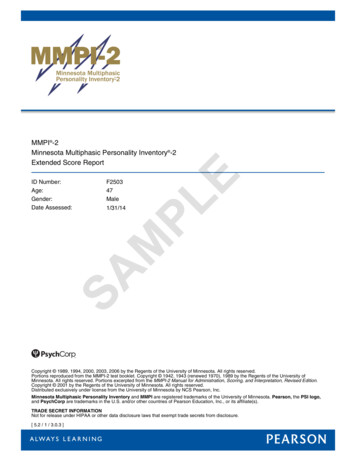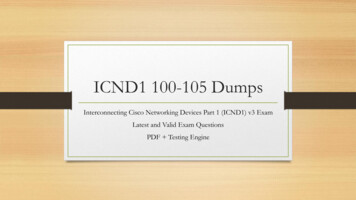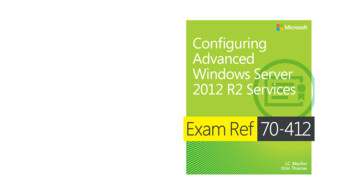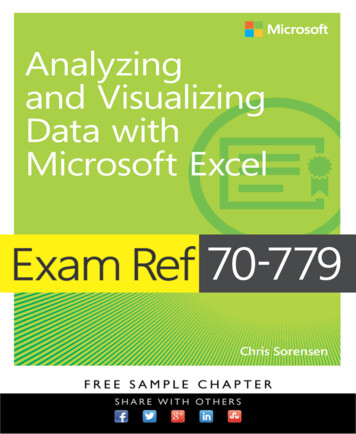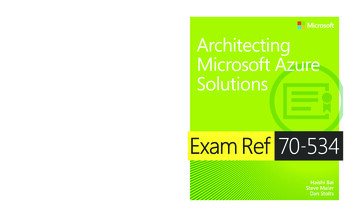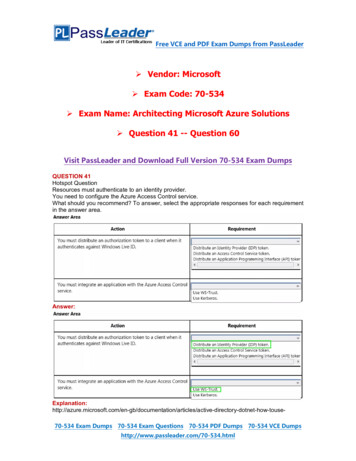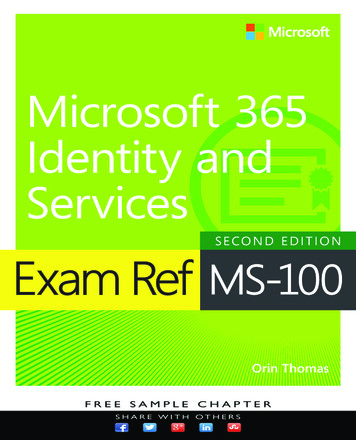
Transcription
Exam Ref MS-100Microsoft 365 Identityand ServicesOrin Thomas9780137469055 print.indb 122/10/21 3:40 PM
Exam Ref MS-100 Microsoft 365 Identity and ServicesPublished with the authorization of Microsoft Corporation by:Pearson Education, Inc.Copyright 2022 by Pearson Education, Inc.All rights reserved. This publication is protected by copyright, and permissionmust be obtained from the publisher prior to any prohibited reproduction,storage in a retrieval system, or transmission in any form or by any means,electronic, mechanical, photocopying, recording, or likewise. For informationregarding permissions, request forms, and the appropriate contacts withinthe Pearson Education Global Rights & Permissions Department, please visitwww.pearson.com/permissions.No patent liability is assumed with respect to the use of the information contained herein. Although every precaution has been taken in the preparation ofthis book, the publisher and author assume no responsibility for errors or omissions. Nor is any liability assumed for damages resulting from the use of theinformation contained herein.ISBN-13: 978-0-13-746905-5ISBN-10: 0-13-746905-5Library of Congress Control Number: 2021948676CREDITSEDITOR-IN-CHIEFBrett BartowEXECUTIVE EDITORLoretta YatesSPONSORING EDITORCharvi AroraDEVELOPMENT EDITORKate ShoupMANAGING EDITORSandra SchroederSENIOR PROJECT EDITORTracey CroomCOPY EDITORLiz WelchINDEXERTimothy WrightPROOFREADERAbigail ManheimScoutAutomatedPrintCodeTECHNICAL EDITORBoyd NolanTRADEMARKSEDITORIAL ASSISTANTCindy TeetersMicrosoft and the trademarks listed at http://www.microsoft.com on the“Trademarks” webpage are trademarks of the Microsoft group of companies.All other marks are property of their respective owners.WARNING AND DISCLAIMEREvery effort has been made to make this book as complete and as accurate aspossible, but no warranty or fitness is implied. The information provided is onan “as is” basis. The author, the publisher, and Microsoft Corporation shall haveneither liability nor responsibility to any person or entity with respect to anyloss or damages arising from the information contained in this book or fromthe use of the programs accompanying it.COVER DESIGNERTwist Creative, SeattleCOMPOSITORcodeMantraSPECIAL SALESFor information about buying this title in bulk quantities, or for special salesopportunities (which may include electronic versions; custom cover designs;and content particular to your business, training goals, marketing focus,or branding interests), please contact our corporate sales department atcorpsales@pearsoned.com or (800) 382-3419.For government sales inquiries, please contactgovernmentsales@pearsoned.com.For questions about sales outside the U.S., please contactintlcs@pearson.com.A01 Thomas FM-pi-xvi.indd 227/10/21 9:49 PM
Pearson’s Commitment toDiversity, Equity, and InclusionPearson is dedicated to creating bias-free content that reflects the diversity ofall learners. We embrace the many dimensions of diversity, including but notlimited to race, ethnicity, gender, socioeconomic status, ability, age, sexualorientation, and religious or political beliefs.Education is a powerful force for equity and change in our world. It has thepotential to deliver opportunities that improve lives and enable economicmobility. As we work with authors to create content for every product andservice, we acknowledge our responsibility to demonstrate inclusivity andincorporate diverse scholarship so that everyone can achieve their potentialthrough learning. As the world’s leading learning company, we have a dutyto help drive change and live up to our purpose to help more people create abetter life for themselves and to create a better world.Our ambition is to purposefully contribute to a world where: Everyone has an equitable and lifelong opportunity to succeed throughlearning.Our educational products and services are inclusive and represent therich diversity of learners.Our educational content accurately reflects the histories and experiencesof the learners we serve.Our educational content prompts deeper discussions with learners andmotivates them to expand their own learning (and worldview).While we work hard to present unbiased content, we want to hear from youabout any concerns or needs with this Pearson product so that we can investigate and address them. 9780137469055 print.indb 3Please contact us with concerns about any potential bias 1 3:40 PM
Contents at a glanceIntroduction9780137469055 print.indb 4xiiiCHAPTER 1Design and implement Microsoft 365 services1CHAPTER 2Manage user identity and rolesCHAPTER 3Manage access and authentication159CHAPTER 4Plan Office 365 workloads and applications223Index3319322/10/21 3:40 PM
ContentsIntroduction Chapter 1xiiiOrganization of this bookxiiiMicrosoft certificationsxivQuick access to online referencesxivErrata, updates, & book supportxivStay in touchxvDesign and implement Microsoft 365 services1Skill 1.1: Plan architecture. . . . . . . . . . . . . . . . . . . . . . . . . . . . . . . . . . . . . . . . . . . . . . . . 1Plan integration of Microsoft 365 and on-premisesenvironmentsIdentify deployment workloads team210Plan an identity and authentication solution11Plan enterprise application modernization14Skill 1.2: Deploy a Microsoft 365 tenant. . . . . . . . . . . . . . . . . . . . . . . . . . . . . . . . . 15Manage domains15Configure organizational settings32Complete the organization profile35Add a Microsoft partner or work with Microsoft FastTrack36Complete the subscription setup wizard38Plan and create a tenant40Edit an organizational profile42Plan and create subscriptions43Configure tenant wide workload settings43Skill 1.3: Manage Microsoft 365 subscription and tenant health. . . . . . . . . . . 53Manage service health alerts53Create an internal service health response plan55Monitor service health56Monitor license allocations57Configure and review reports57v9780137469055 print.indb 522/10/21 3:40 PM
Schedule and review security and compliance reports59Schedule and review usage metrics61Skill 1.4: Plan migration of user and data. . . . . . . . . . . . . . . . . . . . . . . . . . . . . . . . 71Identify data to be migrated and migration methods71Identify users and mailboxes to be migrated andmigration methods76Plan migration of on-premises users and groups83Import PST files88Thought experiment. . . . . . . . . . . . . . . . . . . . . . . . . . . . . . . . . . . . . . . . . . . . . . . . . . . 90Thought experiment answers . . . . . . . . . . . . . . . . . . . . . . . . . . . . . . . . . . . . . . . . . . 90Chapter summary . . . . . . . . . . . . . . . . . . . . . . . . . . . . . . . . . . . . . . . . . . . . . . . . . . . . . 91Chapter 2Manage user identity and roles93Skill 2.1: Design identity strategy . . . . . . . . . . . . . . . . . . . . . . . . . . . . . . . . . . . . . . . 93Evaluate requirements and solution for synchronization94Evaluate requirements and solutions for identitymanagement96Evaluate requirements and solution for authentication97Skill 2.2: Plan identity synchronization by using Azure AD Connect. . . . . . . 98Design directory synchronizationImplement directory synchronization with directoryservices, Federation services, and Azure endpoints byusing Azure AD Connect98105Skill 2.3: Manage identity synchronization by usingAzure Active Directory. . . . . . . . . . . . . . . . . . . . . . . . . . . . . . . . . . . . . . . . . . . . . 108Configure directory synchronization by usingAzure AD Connect108Monitor Azure AD Connect Health124Manage Azure AD Connect synchronization125Configure object filters129Configure password synchronization131Implement multiforest AD Connect scenarios132Skill 2.4: Manage Azure AD identities. . . . . . . . . . . . . . . . . . . . . . . . . . . . . . . . . . 134Plan Azure AD identitiesvi134Contents9780137469055 print.indb 622/10/21 3:40 PM
Implement and manage Azure AD self-servicepassword reset135Manage access reviews137Manage groups138Manage passwords140Manage product licenses143Manage users145Perform bulk user management147Skill 2.5: Manage user roles. . . . . . . . . . . . . . . . . . . . . . . . . . . . . . . . . . . . . . . . . . . . 148Plan user roles148Manage admin roles148Allocate roles for workloads151Manage role allocations by using Azure AD151Thought experiment. . . . . . . . . . . . . . . . . . . . . . . . . . . . . . . . . . . . . . . . . . . . . . . . . . 156Thought experiment answers . . . . . . . . . . . . . . . . . . . . . . . . . . . . . . . . . . . . . . . . . 157Chapter summary . . . . . . . . . . . . . . . . . . . . . . . . . . . . . . . . . . . . . . . . . . . . . . . . . . . . 158Chapter 3Manage access and authentication159Skill 3.1: Manage authentication. . . . . . . . . . . . . . . . . . . . . . . . . . . . . . . . . . . . . . . 159Design an authentication method160Configure authentication164Implement an authentication method165Manage authentication166Monitor authentication170Skill 3.2: Plan and implement secure access . . . . . . . . . . . . . . . . . . . . . . . . . . . . 174Design a conditional access solution175Implement entitlement packages176Implement Azure AD Identity Protection179Manage conditional access187Implement and secure access for guest and external users203Skill 3.3: Configure application access. . . . . . . . . . . . . . . . . . . . . . . . . . . . . . . . . . 210Configure application registration in Azure AD211Configure Azure AD Application Proxy215Publish enterprise apps in Azure AD217Contents9780137469055 print.indb 7vii22/10/21 3:40 PM
Thought experiment. . . . . . . . . . . . . . . . . . . . . . . . . . . . . . . . . . . . . . . . . . . . . . . . . . 219Thought experiment answers . . . . . . . . . . . . . . . . . . . . . . . . . . . . . . . . . . . . . . . . 220Chapter summary . . . . . . . . . . . . . . . . . . . . . . . . . . . . . . . . . . . . . . . . . . . . . . . . . . . . 221Chapter 4Plan Office 365 workloads and applications223Skill 4.1: Plan for Microsoft 365 Apps deployment . . . . . . . . . . . . . . . . . . . . . 223Plan for Microsoft connectivity224Manage Microsoft 365 Apps225Plan for Office online227Assess readiness using Microsoft analytics228Plan Microsoft 365 App compatibility229Manage Office 365 software downloads229Plan for Microsoft apps updates241Plan Microsoft telemetry and reporting242Skill 4.2: Plan for messaging deployments. . . . . . . . . . . . . . . . . . . . . . . . . . . . . . 261Plan migration strategy262Plan messaging deployment268Identify hybrid requirements269Plan for connectivity271Plan for mail routing271Plan email domains272Skill 4.3: Plan for Microsoft SharePoint Online and OneDrivefor Business. . . . . . . . . . . . . . . . . . . . . . . . . . . . . . . . . . . . . . . . . . . . . . . . . . . . . . . 274Plan migration strategy274Plan external share settings275Identify hybrid requirements284Manage access configurations285Manage Microsoft groups287Manage SharePoint tenant and site settings291Manage OneDrive for Business292Skill 4.4: Plan for Microsoft Teams Infrastructure . . . . . . . . . . . . . . . . . . . . . . 296viiiPlan for communication and call quality and capacity296Plan for Phone System297Plan Microsoft Teams deployment297Contents9780137469055 print.indb 822/10/21 3:40 PM
Plan Microsoft Teams organizational settings301Plan for guest and external access305Plan for Microsoft Teams hybrid connectivity and coexistence306Teams cmdlets309Skill 4.5: Plan Microsoft Power Platform integration . . . . . . . . . . . . . . . . . . . . 310Implement Microsoft Power Platform Center ofExcellence (CoE) starter kit311Plan for Power Platform workload deployments311Plan resource deployment317Plan for connectivity (and data flow)320Manage environments320Manage resources323Thought experiment. . . . . . . . . . . . . . . . . . . . . . . . . . . . . . . . . . . . . . . . . . . . . . . . . 327Thought experiment answers . . . . . . . . . . . . . . . . . . . . . . . . . . . . . . . . . . . . . . . . 328Chapter summary . . . . . . . . . . . . . . . . . . . . . . . . . . . . . . . . . . . . . . . . . . . . . . . . . . . 328Index331Contents9780137469055 print.indb 9ix22/10/21 3:40 PM
This page intentionally left blank
About the AuthorORIN THOMA S is a Principal Cloud Advocate at Microsoft. He has written more than threedozen books for Microsoft Press on such topics as Windows Server, Windows Client, Azure,Office 365, System Center, Exchange Server, security, and SQL Server. He has authored AzureArchitecture courses at Pluralsight and has authored multiple Microsoft Official Curriculum andEdX courses on a variety of IT Pro topics. You can follow him on Twitter at http://twitter.com/orinthomas.xi9780137469055 print.indb 1122/10/21 3:40 PM
This page intentionally left blank
IntroductionThe MS-100 exam deals with advanced topics that require candidates to have an excellentworking knowledge of Microsoft 365 identity and services functionality. Some of the examrelates to topics that even experienced Microsoft 365 administrators may rarely encounterunless they are consultants who deploy new Microsoft 365 tenancies on a regular basis. Tosuccessfully pass this exam, candidates not only need to understand how to manage Microsoft365 identity and services, they also need to understand how to integrate Microsoft 365 with anon-premises Active Directory environment. And they must keep up to date with new developments with Microsoft 365, including new features and changes to the interface.Candidates for this exam are information technology (IT) professionals who want to validatetheir advanced Microsoft 365 identity and services management skills, configuration skills, andknowledge. To pass this exam, candidates require a strong understanding of how to design andimplement Microsoft 365 services, manage user identity and roles, manage access and authentication, and understand the steps involved in planning Office 365 workloads and applications.To pass, candidates require a thorough theoretical understanding as well as meaningful practical experience implementing the technologies involved.This edition of this book covers Microsoft 365 and the MS-100 exam objectives in mid-2021.As the Microsoft 365 suite evolves, so do the Microsoft 365 exam objectives, so you shouldcheck carefully if any changes have occurred since this edition of the book was authored andstudy accordingly.This book covers every major topic area found on the exam, but it does not cover everyexam question. Only the Microsoft exam team has access to the exam questions, and Microsoftregularly adds new questions to the exam, making it impossible to cover specific questions.You should consider this book a supplement to your relevant real-world experience and otherstudy materials. If you encounter a topic in this book that you do not feel completely comfortable with, use the “Need more review?” links found in the text to locate more information andtake the time to research and study the topic. Great information is available on MSDN andTechNet and in blogs and forums.Organization of this bookThis book is organized by the “Skills measured” list published for the exam. The “Skills measured” list is available for this exam on the Microsoft Learn website at https://aka.ms/ms-100.Each chapter in this book corresponds to a major topic area in the list, and the technical tasksxiiiA01 Thomas FM-pi-xvi new.indd 1322/10/21 7:08 PM
in each topic area determine a chapter’s organization. If an exam covers six major topic areas,for example, the book will contain six chapters.Microsoft certificationsMicrosoft certifications distinguish you by proving your command of a broad set of skills andexperience with current Microsoft products and technologies. The exams and correspondingcertifications are developed to validate your mastery of critical competencies as you designand develop, or implement and support, solutions with Microsoft products and technologiesboth on-premises and in the cloud. Certification brings a variety of benefits to the individualand to employers and organizations.MORE INFOALL MICROSOFT CERTIFICATIONSFor information about Microsoft certifications, including a full list of available certifications,go to http://www.microsoft.com/learn.Check back often to see what is new!Quick access to online referencesThroughout this book are addresses to webpages that the author has recommended you visitfor more information. Some of these addresses (also known as URLs) can be painstaking totype into a web browser, so we’ve compiled all of them into a single list that readers of the printedition can refer to while they read.Download the list at he URLs are organized by chapter and heading. Every time you come across a URL in thebook, find the hyperlink in the list to go directly to the webpage.Errata, updates, & book supportWe’ve made every effort to ensure the accuracy of this book and its companion content. Youcan access updates to this book—in the form of a list of submitted errata and their amRefMS1002e/errataxivIntroduction9780137469055 print.indb 1422/10/21 3:40 PM
If you discover an error that is not already listed, please submit it to us at the same page.For additional book support and information, please visit MicrosoftPressStore.com/Support.Please note that product support for Microsoft software and hardware is not offeredthrough the previous addresses. For help with Microsoft software or hardware, go tohttp://support.microsoft.com.Stay in touchLet’s keep the conversation going! We’re on Twitter: 137469055 print.indb 15xv22/10/21 3:40 PM
This page intentionally left blank
CHAPTER 2Manage user identity androlesA key aspect of deploying Microsoft 365 is ensuring that user identity is configured properly.When this is done, users can seamlessly access resources in the on-premises environmentas well as in the Microsoft 365 environment. If it is not done correctly, users must juggle different accounts, depending on whether the accessible resources are hosted locally or in thecloud.In this chapter, you will learn about designing an identity strategy, how to plan identitysynchronization with Azure AD Connect, how to manage that synchronization, how to manage Azure AD identities, and how to manage Azure AD user roles.Skills in this chapter: Skill 2.1: Design identity strategy Skill 2.2: Plan identity synchronization by using Azure AD Connect Skill 2.3: Manage identity synchronization by using Azure Active Directory Skill 2.4: Manage Azure AD identities Skill 2.5: Manage user rolesSkill 2.1: Design identity strategyThis skill deals with designing a strategy related to on-premises and cloud-based identity.To master this skill, you’ll need to understand how to determine your organization’s requirements when it comes to synchronization, what an appropriate identity-management solutionis, and what type of authentication solution is appropriate for your environment.This section covers the following topics: Evaluate requirements and solution for synchronization Evaluate requirements and solution for identity management Evaluate requirements and solution for authentication93M02 Thomas C02-p093-158.indd 9326/10/21 3:26 PM
Evaluate requirements and solution for synchronizationSynchronization is the process of replicating on-premises identities, such as users and groups,to the cloud. Synchronization is necessary only when an on-premises identity provider is present. In some synchronization models, every on-premises identity is replicated to the cloud. Inother models, only a subset of the on-premises identities is replicated.Another consideration in evaluating synchronization requirements is determining whatinformation about a user’s identity needs to be synchronized to the cloud. Depending on themodel chosen, some or all of the properties of those on-premises identities can be replicated.For example, some organizations store sensitive private data about employees within ActiveDirectory. Only replicating what is necessary is especially important given the increasing regulation of data involving personal information.Should an organization choose, it is possible to perform a complete replication ofevery aspect of an Active Directory object to the cloud. For example, an organization candeploy a domain controller, SharePoint Farm, System Center, and Exchange Server in Azure infrastructure-as-a-service (IaaS) virtual machines (VMs). You can have those VMs connectedvia VPN or an ExpressRoute connection to an on-premises Active Directory instance. In thisscenario, the Azure IaaS VMs would essentially function as an expensive branch office site running in the Azure cloud.When evaluating requirements and a solution for synchronization, consider the followingquestions: Which identities need to be replicated to the cloud? How often do those identities need to be replicated to the cloud? What properties of those identities need to be replicated to the cloud?Which identities to replicate?Deployment of Microsoft 365 gives organizations an ability to assess their existing identityneeds. If an organization has been using Active Directory for a long time, it’s likely that objectsdon’t need to be replicated to the cloud and probably don’t need to be in the on-premisesActive Directory instance. It’s a good idea, before implementing any Microsoft 365 replicationscheme, to do a thorough audit of all the objects present within the on-premises directory andto clean out those that are no longer required.Another issue to address is whether every on-premises identity needs to be present inAzure Active Directory. Many organizations take a phased approach to the introduction ofMicrosoft 365, migrating small groups of users to the service at a time rather than every userin the organization all at once. Users who are only present in the on-premises directory servicewon’t need to have Microsoft 365 licenses assigned to them.There are also special account types that are commonly present in an on-premises ActiveDirectory instance that do not need to be, or simply cannot be, replicated to Azure ActiveDirectory. For example, there is no need to replicate service accounts or accounts that are usedfor specific administrative purposes for on-premises resources, such as the management of anon-premises SQL Server database server or other workload.94CHAPTER 2 Manage user identity and roles9780137469055 print.indb 9422/10/21 3:40 PM
Another challenge to consider is that many on-premises environments are more complicated than a single Active Directory domain. Some organizations have multidomain ActiveDirectory forests. In addition, since it is a recommended Microsoft secure administrative practice, an increasing number of large organizations have multiforest deployments—for example,an Enhanced Security Administrative Environment (ESAE) forest to store privileged accountsfor the production forest.User accounts are not the only identity that an organization may want to replicate to thecloud. It may be necessary to replicate some groups to the cloud because these groups maybe useful in mediating access to Microsoft 365 workloads. For example, if your organizationalready has a local security group that is used to collect together members of the accountingteam, you may want that group also present as a method of mediating access to resources andworkloads within Microsoft 365.How often to replicate?When evaluating requirements and a solution for synchronization, you need to answer severalimportant questions. For example, how often do the properties of an on-premises identitychange and how soon must those changes be present within Azure Active Directory?You don’t want a user who changes his or her password to have to wait 24 hours before thatnew password can be used against cloud identities. Similarly, if you deprovision a user accountbecause a person’s employment with the organization has terminated, you’ll want that actionto be reflected in limiting access to Microsoft 365 workloads, rather than the user account having continued access for some time after the user’s on-premises identity has been disabled.Although there can be bandwidth considerations around identity synchronization, themajority of such traffic is going to be the replication of changes, also known as delta, ratherthan constant replications of the entire identity database. The amount of bandwidth consumedby delta identity synchronization traffic is often insignificant compared to the bandwidth consumed by other Microsoft 365 workloads and services.Which properties to replicate?Active Directory has been present at some organizations for almost two decades. One of theoriginal selling points of Active Directory was that it could store far more information than justuser names and passwords. Because of this, many organizations use Active Directory to store asubstantive amount of information about personnel, including telephone numbers, the user’sposition within the organization, and the branch office where the user works.When considering a synchronization solution, determine which on-premises Active Directory attribute information needs to be replicated to Azure Active Directory. For example, youmay have an application running in Azure that needs access to the Job Title, Department,Company, and Manager attributes, as shown in Figure 2-1.Skill 2.1: Design identity strategy CHAPTER 29780137469055 print.indb 959522/10/21 3:40 PM
FIGURE 2-1 Which attributes to replicateEvaluate requirements and solutions for identitymanagementEvaluating the requirements and solutions for identity management first involves determiningwhat your organization’s source of authority is. The source of authority is the directory servicethat functions as the primary location for the creation and management of user and groupaccounts. You can choose between having an on-premises Active Directory instance function as a source of authority, or you can have Azure Active Directory function as the source ofauthority.Even though Azure Active Directory is present in a hybrid deployment, the source ofauthority will be the on-premises Azure AD instance. Hybrid deployment accounts are usedfor authentication and authorization purposes with existing on-premises resources as well asMicrosoft 365 workloads.Source of authority is a very important concept when it comes to creating users and groupsin an environment where Azure AD Connect is configured to synchronize an on-premisesActive Directory with the Azure Active Directory instance that supports the Microsoft 365tenancy. When you create a user or group in the on-premises Active Directory instance, theon-premises Active Directory instance retains authority over that object. Objects created96CHAPTER 2 Manage user identity and roles9780137469055 print.indb 9622/10/21 3:40 PM
within the on-premises Active Directory instance that are within the filtering scope of objectssynchronized via Azure AD Connect will replicate to the Azure Active Directory instance thatsupports the Microsoft 365 tenancy.Newly created on-premises user and group objects will only be present within the AzureActive Directory instance that supports the Microsoft 365 tenancy after synchronization hasoccurred. You can force synchronization to occur using the Azure AD Connect SynchronizationService Manager tool.Evaluate requirements and solution for authenticationWhen evaluating authentication requirements, determine whether your organization wantsto still rely on the traditional combination of user name and password or move toward moresophisticated and secure authentication techniques, such as multifactor authentication.When making this determination, many organizations will decide that more secure technologies are appropriate for sensitive accounts, such as those used for administrative tasks, andthat the traditional method of user name and password will be sufficient for the majority ofstandard users.Microsoft and Office 365 support a technology known as modern authentication. Modernauthentication provides a more secure authentication and authorization method than traditional authentication methods. Modern authentication can be used with Microsoft 365 hybriddeployments that include Exchange Online and Teams. All Office and Microsoft 365 tenanciescreated after August 2017 that include Exchange Online have modern authentication enabledby default. Modern authentication includes a combination of the following authentication andauthorization methods, as well as secure access policies: Authentication methods Multifactor authentication, Client Certificate Authentication, and Active Directory Authentication Library (ADAL)Authorization methodsMicrosoft’s implementation of Open Authorization (OAuth)Conditional access policies Mobile application management (MAM) and AzureActive Directory Conditional AccessMORE INFOHYBRID MODERN AUTHENTICATIONYou can learn more about hybrid modern authentication at the following address: erprise/hybrid-modern-auth-overview.EXAM TIPRemember the Azure AD Connect prerequisites.Skill 2.1: Design identity strategy CHAPTER 29780137469055 print.indb 979722/10/21 3:40 PM
Skill 2.2: Plan identity synchronization by usingAzure AD ConnectThis skill section deals with planning the implementation of identity synchronization usingAzure AD Connect as the synchronization solution. To master this skill, you’ll need to draw onsome of the information you learned about in the previous skill as well as how to implement anappropriate Azure AD Connect sign-on option.This section covers the following topics: Design directory synchronizationImplement directory synchronization with
Exam Ref MS-100 Microsoft 365 Identity and Service
